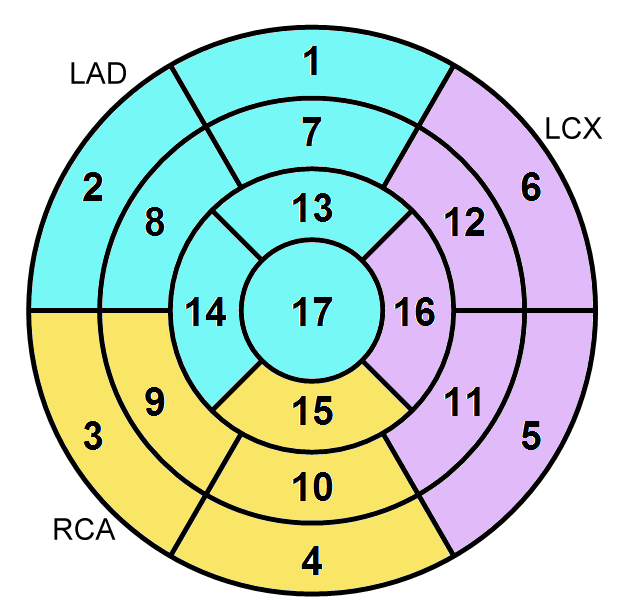Left Ventricle Segmentation Procedure
The muscle and cavity of the left ventricle can be divided into a variable number of segments. Based on autopsy data the AHA recommends a division into 17 segments for the regional analysis of left ventricular function or myocardial perfusion:
▪The left ventricle is divided into equal thirds perpendicular to the long axis of the heart. This generates three circular sections of the left ventricle named basal, mid-cavity, and apical. Only slices containing myocardium in all 360° are included.
▪The basal part is divided into six segments of 60° each. The segment nomenclature along the circumference is: basal anterior, basal anteroseptal, basal inferoseptal, basal inferior, basal inferolateral, and basal anterolateral. The attachment of the right ventricular wall to the left ventricle can be used to identify the septum.
▪Similarly the mid-cavity part is divided into six 60° segments called mid anterior, mid anteroseptal, mid inferoseptal, mid inferior, mid inferolateral, and mid anterolateral.
▪Only four segments of 90° each are used for the apex because of the myocardial tapering. The segment names are apical anterior, apical septal, apical inferior, and apical lateral.
▪The apical cap represents the true muscle at the extreme tip of the ventricle where there is no longer cavity present. This segment is called the apex.

Polar Plots
If functional values have been obtained in the 17 cardiac segments by some quantification method, they can be arranged as a polar plot with the
▪apex in the center,
▪the four apical segments as a first ring,
▪the six mid-cavity segments as the second ring,
▪and the six apical segments as the outermost ring.
Such an arrangement makes it easy to compare the outcome in different conditions (eg. rest/stress) or between patients. The arrangement together with numbers identifying the cardiac segments is illustrated below.

Basal Segments |
Mid-cavity Segments |
Apical Segments |
|||
1. |
basal anterior |
7. |
mid anterior |
13. |
apical anterior |
2. |
basal anteroseptal |
8. |
mid anteroseptal |
14. |
apical septal |
3. |
basal inferoseptal |
9. |
mid inferoseptal |
15. |
apical inferior |
4. |
basal inferior |
10. |
mid inferior |
16. |
apical lateral |
5. |
basal inferolateral |
11. |
mid inferolateral |
17. |
apex |
6. |
basal anterolateral |
12. |
mid anterolateral |
The relative contribution of the basal, mid-cavity, and apical segments are 35% (6/17), 35% (6/17), and 30% (5/17), respectively.
Coronary Artery Territories
The AHA guidelines emphasize that there is a "tremendous variability in the coronary artery blood supply to myocardial segments". The greatest variability occurs at the apical cap, which can be supplied by any of the three arteries. With the recognition of the anatomic variability the individual segments may be assigned to specific coronary artery territories as follows.
Coronary Artery: |
Segments |
Left Anterior Descending (LAD) |
1, 2, 7, 8, 13, 14, 17 |
Right Coronary Artery (RCA) |
3, 4, 9, 10, 15 |
Left Circumflex (LCX) |
5, 6, 11, 12, 16 |